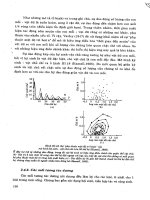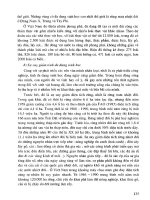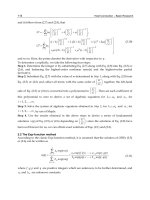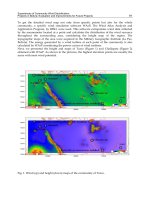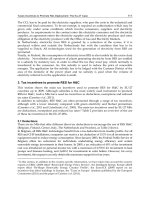Energy Storage Part 6 pot
Bạn đang xem bản rút gọn của tài liệu. Xem và tải ngay bản đầy đủ của tài liệu tại đây (2.28 MB, 13 trang )
Energy Storage
56
sin
ω
t are multiplied by the d-axis component sign prior to being applied to the converter
control circuit. When the system operates correctly, i.e. according to equation (19), the
functions cos
ω
t and sin
ω
t are directly applied to the converter control circuit. When the
function cos
ω
t is phase-shifted with respect to the synchronizing voltage u
a
by
π
(equation
22) the multiplication of cos
ω
t and sin
ω
t functions by the sign of d-axis component (”-1”)
reverses their phases and the correct values of cos
ω
t and sin
ω
t functions are applied to the
converter control circuit.
Figure 20 illustrates the synchronization circuit operation, the time graphs are recorded in
the laboratory setup using the SignalTap II Logic Analyzer tool (a part of the Quartus II
package).
Fig. 20. The time graphs of cos
ω
t function, and the synchronizing voltages waveforms
recorded in the experimental setup
Figure 20 shows the oscillograms of phase voltages u
a
, u
b
, u
c
, the generated cos
ω
t function,
and q-axis component (the controller in figure 19 input error). In the presented
synchronizing circuit implementation all quantities are represented by eleven-bit numbers
plus a sign bit. Instantaneous values of these quantities can vary within the range ±2047.
According to equation (20) the values of q-axis component are equal zero if the
synchronizing voltages are consistent with (19), i.e. are not distorted. Due to the power
system voltage harmonic distortion with 1±6n harmonics (where n= 0, 1, 2…) the values
recorded in axis q are different from zero. These values were varying over the range ±98,
what makes 4.78% of permissible range.
11.2 Investigation of the converter
Figure 21 shows the waveforms of the voltage and current in phase A and the output
voltage. As follows from figure 21 the proposed system allows obtaining the rectified
voltage value higher than the phase voltage amplitude and forces a sinusoidal current,
cophasal with the phase voltage. Figure 22 shows phasor diagrams for several selected
parameters of the converter input voltage.
Figure 22a illustrates the case where the source current is cophasal with the supply voltage
(cosϕ= 1). In figure 22b the source current is lagging (cosϕ≠ 1), i.e. a reactive component
occurs in the source current. Diagrams in figures 22c and 22d are determined for the inverter
mode operation (energy is fed back into the power system). As can be seen from the phasor
diagrams, the source current fundamental harmonic cosϕ (lagging or leading) can be
influenced on by means of shaping the converter input voltage (u
in
) and energy can be fed
back into the power system. Example waveforms in figure 23 illustrate the transition from
the rectifier to inverter mode of operation (energy is fed back into the power system).
The High-speed Flywheel Energy Storage System
57
2,5ms
550V/div
u
ina
300V/div
u
a
20A/div
i
a
Fig. 21. The waveforms of the phase voltage and current u
a
, i
a
and the input voltage u
ina
in
phase A
a)
s
I
s
U
s
X I
d
in
U
b)
s
X I
d
s
U
s
I
in
U
ϕ
q
I
d
I
ϕ
in
U
s
U
s
I
d
I
q
I
d)
s
X I
d
in
U
s
U
s
I
c)
s
X I
d
Fig. 22. Phasor diagrams for several selected parameters of the input voltage U
in
vector
200V/div
u
CF
10A/div
i
load
300V/div
u
a
i
a
10ms
20A/div
Fig. 23. The waveforms of the load current i
load
, the output capacitor voltage u
CF
, the voltage
and current in phase A
Energy Storage
58
As follows from figure 23, at the instant the load current direction is reversed, energy is
transferred to the capacitor and its voltage u
CF
increases what, in turn, influences the source
current phase shift in such a way that energy stored in the capacitor is fed back into power
system.
The described converter is intended for co-operation with an inverter supplying a flywheel
energy storage drive. Thus, in order to ensure constant operating conditions of the inverter-
motor system, the rectifier should maintain the capacitor voltage at the set value
irrespectively of the load current i
load
value and direction. Figures 14 and 15 show the
waveforms recorded at a step change in the load current.
As can be seen from figure 23 at the instant of an increase in the load current the capacitor is
discharging (the capacitor voltage decreases) and, consequently, the control system increases
the phase current amplitude. Energy is supplied in an amount sufficient to compensate the
capacitor voltage decrease resulting from the load current change and provide energy being
drawn from the capacitor by the load. When the capacitor voltage becomes equal to the set
voltage value of the phase current amplitude decreases to the value which ensures the
capacitor voltage is maintained at the required level. In the event of an abrupt change in the
load current a reactive component may occur in the phase current, as is shown in figure 25.
25ms
200V/div
u
CF
10A/div
i
load
300V/div
u
a
20A/div
i
a
Fig. 24. The waveforms of the load current i
load
, the output capacitor voltage u
CF
, the voltage
and current in phase A in response to a step-change in the load current
200V/div
u
CF
10A/div
i
load
300V/div
u
a
20A/div
i
a
5ms
Fig. 25. The waveforms of the load current i
load
, the output capacitor voltage u
CF
, the voltage
and current in phase A; a reactive component i
q
occurs in the source current
The High-speed Flywheel Energy Storage System
59
12. A flywheel energy storage drive control system
Figure 26 shows the diagram of power processing unit (power supply and inverters) and
illustrates the mechanical structure of flywheel energy storage.
AC/DC
C
d
L
i
Load
DC/AC BLDCPM
Flywheel
DC/AC BLDCPM
3x400 V
P
max
=100 kW
U
d
=700 V
L
m
L
m
AI 160≤
I
max
= 100 A; I = 82 A
U
max
= 500 V
I
max
= 100 A; I = 82 A
U
max
= 500 V
N
N
I
T
=100 A
U
T
=1700 V
I
T
=100 A
U
T
=1700 V
I
T
< 230 A
U
T
< 1300 V
T
1F1
T
3F1
T
5F1
T
4F1
T
6F1
T
2F1
T
1F1
T
3F1
T
5F1
T
4F1
T
6F1
T
2F1
T
1R
T
3R
T
5R
T
4R
T
6R
T
2R
L
1
L
2
L
3
u
cap
Motor/
genarator
Hall sensor
6
Magnet
Bearing
Magnet
Bearing
Motor/
genarator
Flywheel
Vacuum
chamber
i
AF1
i
BF1
i
CF1
i
A
F
2
i
B
F
2
i
C
F
2
L
M1
L
M2
Fig. 26. High-speed flywheel energy storage: a – block diagram, b - power processing unit
diagram
Two brushless permanent magnet DC motor are mounted on a common shaft. Magnetic
bearings levitate the spinning mass in order to minimize the resistance to motion. The whole
structure is enclosed in a vacuum chamber. The motor shaft positioning with respect to the
stator is achieved by means of Hall sensors. they determine the instances of switching the
inverter switches based on the actual rotor position relative to stator windings axes. The
layout of magnets and windings of both motors is the same, thus the instants of
commutation are determined by means of a single sensor, common for both motors. Each of
the two FES motors is supplied from an independent inverter, of identical structure. Figure
28 shows diagram of the inverters control system.
Energy Storage
60
The following symbols are used in figure 28: H
A
, H
B
, H
C
– the Hall encoder signals (the rotor
position with respect to stator), MUX – multiplexer, SAW – symmetric sawtooth signal
generator, u
cap
– DC link capacitor voltage, ABS – absolute value, KS – sign comparator, i
xFy
–
(x= A, B, C; y= 1, 2) the motors phase currents. The PWM generators sawtooth signals of
both motors are shifted by T/2; consequently, the DC link capacitor current alternating
component is doubled thereby reducing torque ripples at the FES shaft.
The converter controls the DC link capacitor voltage and if it drops below the predefined
level the speed of 1/3 ω
max
is set in the control system. The system turns from the motor
mode to generator mode and the mechanical energy is converted into electrical energy. The
capacitor voltage is also controlled during the converter start-up. The inverters remain
blocked until the instant of a correct start-up of the line-side converter. The motor actual
rotational speed is determined from the frequency of the Hall sensor signals. An algorithm
for computing the frequency is described further below.
Fig. 27. Photograph of the FES mechanical structure
The High-speed Flywheel Energy Storage System
61
Σ
Σ
Σ
zs
k
ω
ω
ωω
ek
m
k
ω
ω
Σ
MUX
Σ
Σ
Σ
Fig. 28. The inverters' control system
The motors operate at a common shaft and rotate with same speed, therefore the inverters
control system (Fig. 28) utilizes a single speed controller, common for both inverters. The
speed controller output signal is proportional to the drive current reference value. In order
to protect the system against an uncontrolled increase in the DC-link capacitor current the
controller output signal is limited to a selected value proportional to the capacitor maximum
voltage. This limitation determines the inverters' maximum current. When motors are
operated in the generator mode the current limit level must be reduced depending on the
instantaneous value of the DC-link capacitor voltage. When the energy recovered from the
spinning mass (i.e. delivered to the capacitor) is larger than that supplied by the line-side
converter to the supply line, the capacitor voltage increases. An increase in the capacitor
voltage results in reduction of the speed controller output limit (i
max
) and thereby the drive
current limiting. If the capacitor voltage reaches its maximum permissible value the set
current decreases to zero. The principle is illustrated in figure 29.
i
MAX
u
cap
100A
0A
650V
700V
Fig. 29. The DC-link capacitor voltage (alternate component) and the speed controller output
limitation (maximum permissible inverter current) versus time
Direction of energy transfer: power supply network ⇒ spinning energy storage (the inertial
element ⇒ power supply network) is determined by the sign of the speed control error. If
the set speed is lower than the actual rotation speed, the motors turn into generating mode
(regenerative braking). In the alternate case the control error is grater than zero, the motors
are accelerated or energy supplied from the power network compensates losses resulting
from the resistance to motion. The control system automatically sets zero speed if the DC-
link capacitor voltage is lower than 0.9 of its nominal value. This condition limits the supply
Energy Storage
62
line current during the line-side converter start-up. The drive is started only if the capacitor
is charged to 0.9U
N
with delay of 2 seconds. In the event of voltage loss in the supply line,
resulting in the capacitor voltage reduction, the system automatically turns to the generator
mode.
The speed controller output signal (the current reference) is compared with the sum of
absolute values of the motors phase currents. The inverters' current error (k
iR
e
i
) is applied to
the PI current controller. Each inverter is provided with an independent controller divided
into two parallel components: the proportional and integral part. Both parts of the controller
have their own limits. The controller integrator incorporates a limiter that prevents counting
when the integer value reaches a predefined maximum level. A separate limitation at the
controller output prevents reaching the output signal values that cannot be executed by the
control circuit. This limitation results from PWM generators operation area range.
The block termed "Commutation Logic", shown on the diagram in figure 3 is responsible for
correct switching of the inverters' transistors, depending on the permanent magnets position
with respect to the stator windings. Time relations between the motor electromotive force
(e
A
, e
B
, e
C
), Hall sensors signals (H
A
, H
B
, H
C
), transistor switches control pulses (T
1
, T
2
÷ T
6
)
and phase currents (I
A
, I
B
, I
C
) are shown in figure 30 (Fig. 30a refers to the motor mode
operation, Fig. 30b refers to the generator mode). As can be seen from figure 30, logic
functions controlling the switches in the motor and generator mode operation are different
(transistor gate control pulses are shifted by T/2). The "Commutation Logic" block structure
is shown in Fig. 31 The "Pulse Blocking" input is employed for blocking all transistors
during starting (until the capacitor voltage reaches 0.9U
N
) and to turn off the line-side
converter upon detection of exceeding the current permissible value.
The position sensor shall change its logic state at the angular distance of π/6 from the motor
phase voltage (e
A
, e
B
, e
C
) zero crossing. The current flows always through windings in which
maximum voltage value occurs (Fig. 30). Therefore, during a full revolution of the rotor each
of the inverter's transistors conducts during 2π/3 of the cycle and participates in two from
the six allowable pairs: T
1
T
2
, T
2
T
3
, T
3
T
4
, T
4
T
5
, T
5
T
6
, T
6
T
1
. Since only two switches can conduct
simultaneously, in order to minimize switching losses only one transistor of a pair is
chopper controlled while the other is continuously turned on. To ensure uniform heating of
a transistor module a transistor is continuously turned on during ½ of the conducting
period, while during the other half it is chopper controlled. In figure 30 the transistor
switching process is indicated by shaded area. Figure 31a depicts the rotor position sensor
signals and transistors gate control pulses (the waveforms recorded in Quartus II
programme using the SignalTap II Logic Analyzer tool). Figure 31b shows oscillogram of the
phase current waveform and a transistor gate control pulses. From the principle of inverter
operation it follows that conduction times (pulse duty factor) of all the inverter transistors
are the same. The PWM generator module operates in a continuous manner; the
commutation logic, shown in figure mb.6, is responsible for assignment of control signals to
individual transistors (depending on the rotor position with respect to stator).
In this figure each transistors has assigned its individual control signal PWM
x
(x= 1, 2 … 6),
which is a logical function of the common control PWM and the position sensors pulses; the
functions for both the motor and generator operation mode are listed in table 2. The
separation of the common control and the use of an appropriate logical function allows
limitation of transistors switching losses according to the idea illustrated in figures 30 and
31. Logical functions listed in table mb.1 and logical circuits from figure mb.6, are
exclusively correct for the phase sequence shown in figure 30.
The High-speed Flywheel Energy Storage System
63
e
A
e
B
e
C
H
A
H
B
H
C
T
1
T
2
T
3
T
4
T
5
T
6
I
A
I
B
I
C
t
ω
t
ω
t
ω
t
ω
t
ω
t
ω
t
ω
t
ω
t
ω
t
ω
t
ω
t
ω
t
ω
t
ω
t
ω
H
A
xH
B
H
A
xH
C
H
B
xH
C
H
B
xH
A
H
C
xH
A
H
C
xH
B
a)
e
A
e
B
e
C
H
A
H
B
H
C
T
1
T
2
T
3
T
4
T
5
T
6
I
A
I
B
I
C
t
ω
t
ω
t
ω
t
ω
t
ω
t
ω
t
ω
t
ω
t
ω
t
ω
t
ω
t
ω
t
ω
t
ω
t
ω
H
b)
A
xH
B
H
B
xH
A
H
C
xH
A
H
C
xH
B
H
B
xH
C
H
A
xH
C
Fig. 30. Time relations between the motor back emf, phase currents, Hall sensors signals and
the inverter switches control pulses; a) motor mode operation, b) generator mode operation
Energy Storage
64
Transistor Motor Generator
T
1
= PWM
1
PWM or (H
A
and H
C
) PWM or (not(H
A
) and not(H
C
))
T
2
= PWM
2
PWM or (not(H
B
) and not(H
C
)) PWM or (H
B
and H
C
)
T
3
= PWM
3
PWM or (H
A
and H
B
) PWM or (not(H
A
) and not(H
B
))
T
4
= PWM
4
PWM or (not(H
A
) and not(H
C
)) PWM or (H
A
and H
C
)
T
5
= PWM
5
PWM or (H
B
and H
C
) PWM or (not(H
B
) and not(H
C
))
T
6
= PWM
6
PWM or (not(H
A
) and not(H
B
)) PWM or (H
A
and H
B
)
Table 2. Logical functions for individual transistors control that allow minimizing switching
losses
H
A
H
B
H
C
T
1
T
2
T
3
T
4
T
5
T
6
(a)
(b)
Fig. 31. a) Hall sensors signals and transistors gate control pulses; b) The motor phase
current and transistor gate control pulses limiting switching losses
13. Speed measurement
The converter control system utilizes signals from rotor position sensors to detect which
winding conducts current and, basing on their frequency, determines the speed of FES
rotation. Using these signals the control algorithm can detect sensor failure (loss of
The High-speed Flywheel Energy Storage System
65
connection integrity) or locked rotor (because of e.g. bearings failure). If the logical state in
all three signal lines (HA, HB, HC) does not change over a specified time interval, transistors'
control pulses are blocked. This action protects the motor windings against overheating due
to continuous current conduction. This blocking is independent of the speed measurement
because the algorithm of digital speed measurement assumes a minimum determinable
speed value, whereas the described failure detection method works correctly also at
arbitrary low speeds. This is of particular importance when motors are started from zero
speed.
The rotational speed measurement algorithm shall ensure the frequency of the output signal
to be as high as possible and possible misalignment shall not impact the measurement
result. Ideally, in a theoretical case, the position sensor pulses (HA, HB, HC) duty factor is
50%. If the Hall sensor axis is misaligned with respect to the motor shaft axis, or the sensor is
not mounted perpendicularly to the shaft, the duty factor differs from the required value.
The cycle of each of the three rotor position signals equals one period of the shaft revolution
(for a two-pole pair motor) or a half of the revolution period - for a four-pole motor. Since
the position sensor signals are shifted with respect to each other by 1/3 T, then determining
the cycle of each signal (using either a rising or a falling edge) the measurement frequency is
three times the rotation frequency (for a two-pole motor). The speed measurement
frequency can be doubled determining the signal half-cycle (using both the rising and
falling edge) and employing a supplementary register that stores the determined value of
the preceding half-cycle. For each change in the sensor signal level the determined signal
period is the sum of the current measurement result and that being stored in the
supplementary register. The flowchart of the algorithm determining the sensor signal period
is shown in figure 32.
The algorithm from figure mb.9 is executed in an infinite loop independently for each of
three signals. Each step is executed on the rising edge of the clock signal (CLK) of known
frequency. The internal counter representing the revolution period is incremented by one at
the clock rising edge (the variable Counter in Fig. 32), next the level of the Hall sensor signal
(HA, HB, HC) is checked. A change of logical state is interpreted as completing 1/2 of shaft
revolution (1/4 for a motor with two pole-pairs). In such a case in supplementary registers
(R2_x, R1_x where x= A, B, C) the current and the preceding value of counter is stored. The
sum of the R2_x, R1_x registers values represents the rotational speed (frequency computed
from completing a full revolution). If the sensor logical state did not change the counter
value is checked and when it attains the specified maximum value it is assumed that the
motor is stopped and its rotational speed is zero. In the case of a motor with two pole-pairs
four supplementary registers are required, each of them stores the duration of the
consecutive fourth part of a revolution. Figure 33 shows the waveforms recorded in
Quartus II programme illustrating practical realization of the described algorithm. The
variable Counter
(Fig. 32) has not been taken into account in the practical realization, is
function is fulfilled by the register R1_x.
The following symbols are used in figure 33:
H
A
, H
B
, H
C
– pulses from the rotor position sensor determining the current commutation
instants (e.g. Hall sensor, sensorless method),
G
A
, G
B
, G
C
– signals of the rotor position sensors state change (pulse edge detection),
G
I
– the speed controller timing signal.
Energy Storage
66
START
Counter:=0
CLK
Counter + 1
Level
changed?
Counter=max
Counter:=0
CLK
NO
NO
NO
YES
Sensor Hx
YES
YES
R2_x:=R1_x;
R1_x:=Counter
Result:=R1_x+R2_x;
Fig. 32. Flowchart of the algorithm determining the frequency of a single Hall sensor signal
H
A
H
B
H
C
G
A
G
B
G
C
G
i
R1_A
R1_B
R1_C
R2_A
R2_B
R2_C
n
H
A
H
B
H
C
G
i
Fig. 33. The principle of the rotational speed measurement – a practical realization
The High-speed Flywheel Energy Storage System
67
Duration of the position sensor high and low states (a half of a revolution for a motor with
one pair of poles or a quarter of a revolution for a motor with two pole-pairs) is timed by
counting pulses of a known frequency between the consecutive pulses Gx (x= A, B, C). The
rising edge Gx resets the R1_x (x= A, B, C) register counter (Fig. 27). Prior to resetting the
R1_x register, its value is rewritten to the supplementary register R2_x. Knowing the
reference signal frequency (f
CLK
) and states of the registers R1_x and R2_x at falling edge of
the GI signal we can determine the motor rotational speed from equation (23)
60
1_ 2_
CLK
f
n
RxRx
=
+
(23)
14. References
Aanstoos, T.A. Kajs, Brinkman J. P., Liu W.G., Ouroua H. P., Hayes A., Hearn R.J., Sarjeant
C., Gill J., H.: High voltage stator for a flywheel energy storage system; Center for
Electromech., Texas Univ., Austin, TX; Magnetics, IEEE Transactions on
04/25/2000 -04/28/2000, Jan 2001 Location: San Francisco, CA, USA
Acarnley P.P., Mecrow B. C., Burdess J. C., Fawcett J. N., Kelly J. G., Dickinson P. G.: Design
Principles for a Flywheel Energy Store for Road Vehicles, IEEE Transactions on Industry
Application vol. 32, no 6, 1996,
Akagi H., Sato H.: Control and performance of a doubly-fed induction machine intended for a
flywheel energy storage system, IEEE Transactions on Power Electronics, Volume: 17
Issue: 1, Jan 2002,
Curtiss, D.H. Mongeau, P.P. Puterbaugh, R.L.: Advanced composite flywheel structural design
for a pulsed disk alternator; Kaman Electromagnetics Corp., Hudson, MA; Magnetics,
IEEE Transactions on 04/20/1994 -04/24/1994, 20-24 Apr 1994 San Diego, CA,
USA.
Davies T. A., Jefferson C. M.: Wind-power flywheel integration Dept. of Eng., Bristol Polytech:
Energy Conversion Engineering Conference, 1989. IECEC-89. Proceedings of the
24th Intersociety 08/06/1989 -08/11/1989, 6-11 Aug 1989 Washington, DC, USA;
page(s): 2071-2076 vol. 4.
Davies, T.S. Larsen, N. A: Regenerative drive for incorporating flywheel energy storage into wind
generation systems; Energy Conversion Engineering Conference, 1989. IECEC-89.
Proceedings of the 24th Intersociety 08/06/1989 -08/11/1989, 6-11 Aug 1989
Washington, DC, USA; page(s): 2065-2069 vol.4 6-11 Aug 1989.
Ginter, S. Gisler, G. Hanks, J. Havenhill, D. Robinson, W. Spina, L. SatCon Technol. Corp.,
Tucson, AZ; Spacecraft energy storage systems: IEEE Aerospace and Electronics
Systems Magazine; page(s): 27-32 Volume: 13, May 1998.
Gosiewski Z., Kulesza Z.: Wykorzystanie układów FPGA do sterowania siłowników łożyska
magnetycznego., "Pomiary, Automatyka, Robotyka" R.11, nr 2/2007.
Gully, J.H. Pratap, S.B. Headifen, R.N. Marinos, C. Dick, W. Goodel, B.: Investigation of an
alternator charged pulse forming network with flywheel energy storage Center for
Electromech., Texas Univ., Austin, TX; Magnetics, IEEE Transactions on
04/28/1992 -04/30/1992, 28-30 Apr 1992.
Energy Storage
68
Hall C. D.: High Speed Flywheels for Integrated Energy Storage and Attitude Control. Department
of Aeronautics and Astronautics Air Force Institute of Technology/ENY Wright-
Petterson Air Force Base, Ohio 45433, Sept. 24, 1997.
Hebner R., Beno J., Walls A.: Flywheel Batteries Come Around Again, IEEE Spectrum April,
2002.
Kamiński G., Szczypior J., Biernat A., Smak A., Rowiński A., Kowalski W.: Konstrukcja
modelu maszyny do elektromechanicznego magazynowania energii, Przegląd
Elektrotechniczny 6, 2008.
Kamiński G., Szczypior J., Smak A.: Analiza kształtu zwojów uzwojeń twornika bezrdzeniowego
w maszynach do kinetycznych magazynów energii. Przegląd Elektrotechniczny LXXXI,
10, 2005, str. 7-14.
Kamiński G., Szczypior J., Smak A.: Analiza uzwojeń tworników bez rdzeni ferromagnetycznych
w maszynach kinetycznych magazynów energii, SME Opole 2005.
Kamiński G., Szczypior J., Smak A.: Wybrane problemy konstrukcji maszyny bezszczotkowej
stosowanej w kinetycznym magazynie energii. SME Opole 2005.
Kulesza Z., Gosiewski Z.: An FPGA implementation of the robust controller for the active
magnetic bearing system, 4th International Conference "Mechatronic Systems and
Materials, MSM 2008". Abstract book. Bialystok 2008. s. 126.
Kulesza Z., Gosiewski Z.: An FPGA implementation of the robust controller for the active
magnetic bearing system. "Solid State Phenomena", Vol. 147-149 (2009), s. 399-409.
Mason L.: Flywheel Power System, NASA Lewis Research Center, Flywheel Workshop, Oct. 7,
1998.
Mulcahy, T.M. Hull, J.R. Uherka, K.L. Abboud, R.G. Juna, J.J.: Test results of 2-kWh flywheel
using passive PM and HTS bearings, Argonne Nat. Lab., IL; Applied
Superconductivity, IEEE Transactions on 09/17/2000 -09/22/2000, Mar 2001.
Piróg S., Siostrzonek T., Penczek A., Czekoński J.: Wirujący zasobnik energii z bezszczotkowym
silnikiem prądu stałego – wyniki badań laboratoryjnych VIII Konferencja Naukowa
„Sterowanie w Energoelektronice i Napędzie Elektrycznym” SENE'2007 (pod
auspicjami European Power Electronics and Drives Association) Pol. Łódzka Łódź
21-23 listopad 2007 (materiały konferencji t. II, str. 379-385
Piróg S., Siostrzonek T., Penczek A.: The flywheel energy storage with brushless DC motor
International conference on Power ELectronics and Intelligent Control for Energy
Conservation: Warsaw, Poland, October 16–19, 2005.
Piróg S.: Elektromechaniczne magazyny energii Napędy i Sterowanie nr. 12 2006, str. 115-132.
Piróg S.: Magazyny energii SENE 2007: VIII krajowa konferencja naukowa Sterowanie
w Energoelektronice i Napędzie Elektrycznym, Łódź, 21–23 listopada 2007 r.

